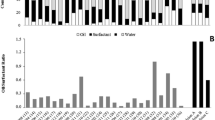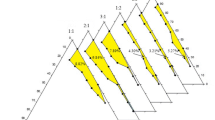Abstract
In the present study, the influence of perfumes on the interfacial curvature of microemulsions is investigated. The hydrophilic-lipophilic deviation (HLD) concept was applied to nonionic Winsor I type systems (O/W microemulsions in equilibrium with an oil excess phase) containing a mixture of oils with isopropyl myristate as supporting oil and a variety of liquid solutes as co-oil for which an Equivalent Alkane Carbon Number of the mixture (EACNmix) was defined. Temperature was used as a formulation variable and the phase inversion temperature change, provoked by the solubilization of different solutes, was determined. The hydrodynamic radius of the droplet and the interfacial solubilization of fragrances were measured subsequently and correlated to the EACNmix. In a first step, selected perfumery raw materials (PRMs) were used as solutes and were studied separately. It was demonstrated that the PRMs can be classified in interfacial solubility according to their chemical functionalities and they follow the order alcohols > aldehydes > terpenes > aromatics > alkanes. Solutes that lead to low EACNmix values (<6) have preferential interfacial solubility and provoke strong curvature changes, whereas those leading to higher EACN values (>6) typically do not change the curvature significantly. The HLD method was also applied to complex fragrances and it was demonstrated that they can be considered as single, non-polar entities, and studied as such instead of investigating each raw material included in the composition separately. Determination of the dimensionless number EACNmix offers the possibility of classifying perfumes in an environment similar to surfactant formulations of typical consumer products and to predict the interaction with the surfactant base according to the rules established on the basis of the individual raw materials.









Similar content being viewed by others
References
Tokuoka Y, Uchiyama H, Abe M, Ogino K (1992) Solubilization of synthetic perfumes by nonionic surfactants. J Colloid Interface Sci 152:402–409
Munden DR (1988) Effect of perfumes on the viscosity of surfactant systems. Cosmet Toilet 103:65–67
Tchakalova V, Testard F, Wong K, Parker A, Benczédi D, Zemb T (2008) Solubilization and interfacial curvature in microemulsions: I. Interfacial expansion and co-extraction of oil. Colloids Surf A 331:31–39
Tchakalova V, Testard F, Wong K, Parker A, Benczédi D, Zemb T (2008) Solubilization and interfacial curvature in microemulsions: II. Surfactant efficiency and PIT. Colloids Surf A 331:40–47
Kanei N, Tamura Y, Kunieda H (1999) Effect of types of perfume compounds on the hydrophile-lipophile balance temperature. J Colloid Interface Sci 218:13–33
Kayali I, Qamhieh K, Lindman B (2006) Effect of type of fragrance compounds on their location in hexagonal liquid crystal. J Dispersion Sci Technol 27:1151–1155
Kayali I, Khan A, Lindman B (2006) Solubilization and location of phenethylalcohol, benzaldehyde, and limonene in lamellar liquid crystal formed with block copolymer and water. J Colloid Interface Sci 297:792–796
Fischer E, Fieber W, Navarro C, Sommer H, Benczédi D, Velazco MI, Schönhoff M (2009) Partitioning and localization of fragrances in surfactant mixed micelles. J Surfact Deterg 12:73–84
Kahlweit M, Strey R, Firman P (1986) Search for tricritical points in ternary systems: water-oil-nonionic surfactant. J Phys Chem 90:671–677
Kahlweit M, Strey R (1987) Phase behavior of quinary systems: tracing the three-phase body. J Phys Chem 91:1553–1557
Kahlweit M, Strey R, Busse G (1990) Microemulsions: a qualitative thermodynamic approach. J Phys Chem 94:3881–3894
Strey R, Jonströmer M (1992) Role of medium-chain alcohols in interfacial films of nonionic microemulsions. J Phys Chem 96:4537–4542
Salager J-L, Marquez N, Graciaa A, Lachaise J (2000) Partitioning of ethoxylated octylphenol surfactants in microemulsion-oil-water systems: influence of temperature and relation between partitioning coefficient and physicochemical formulation. Langmuir 16:5534–5539
Salager JL, Anton RE, Sabatini DA, Harwell JH, Acosta EJ, Tolosa LI (2005) Enhancing solubilization in microemulsions—state of the art and current trends. J Surfact Deterg 8:3–21
Kunz W, Testard F, Zemb T (2009) Correspondence between curvature, packing parameter, and hydrophilic-lipophilic deviation scales around the phase-inversion temperature. Langmuir 25:112–115
Salager JL, Anton R, Andérez JM, Aubry JM (2001) Formulation des microémulsions par la méthode du HLD. Tech l’Ingénieur Traité Génie des procédés J2157:1–19
Queste S, Salager JL, Strey R, Aubry JM (2007) The EACN scale for oil classification revisited thanks to fish diagrams. J Colloid Interface Sci 312:98–107
Bouton F, Durand M, Nardello-Rataj V, Serry M, Aubry JM (2009) Classification of terpene oils using the fish diagrams and the Equivalent Alkane Carbon (EACN) scale. Colloids Surf A 338:142–147
Bouton F, Durand M, Nardello-Rataj V, Borosy A, Quellet C, Aubry JM (2009) A QSPR model for the prediction of the “fish-tail” temperature of CiE4/water/polar hydrocarbon oil systems. Langmuir 338:142–147
Soper AK, Benmore CJ (2008) Quantum differences between heavy and light water. Phys Rev Lett 101:0655021–0655024
Whiddon C, Söderman O (2001) Unusually large deuterium isotope effects in the phase diagram of a mixed alkylglucoside surfactant/water system. Langmuir 17:1803–1806
Graciaa A, Lachaise J, Cucuphat C, Bourrel M, Salager JL (1993) Improving solubilization in microemulsions with additives. 2. Long chain alcohols as lipophilic linkers. Langmuir 9:3371–3374
Acosta E, Szekeres E, Sabatini D, Harwell (2003) Net-average curvature model for solubilization and supersolubilization in surfactant microemulsions. Langmuir 19:186–195
Strey R (1994) Microemulsion microstructure and interfacial curvature. Colloid Polym Sci 272:1005–1019
Testard F, Zemb T (1998) Excess of solubilization of lindane in nonionic surfactant micelles and microemulsions. Langmuir 14:3175–3181
Testard F, Zemb T (1999) Excess of solubilization and curvature in nonionic microemulsions. J Colloid Interface Sci 219:11–19
Graciaa A, Lachaise J, Cucuphat C, Bourrel M, Salager JL (1993) Interfacial segregation of an ethyl oleate/hexadecane oil mixture in microemulsion systems. Langmuir 9:1473–1478
Acknowledgments
We thank Christine Vuilleumier for the measurement of the log P values of the PRMs and Sandy Frank for the measurement of the NMR spectra.
Author information
Authors and Affiliations
Corresponding author
About this article
Cite this article
Tchakalova, V., Fieber, W. Classification of Fragrances and Fragrance Mixtures Based on Interfacial Solubilization. J Surfact Deterg 15, 167–177 (2012). https://doi.org/10.1007/s11743-011-1295-y
Received:
Accepted:
Published:
Issue Date:
DOI: https://doi.org/10.1007/s11743-011-1295-y




